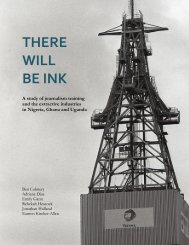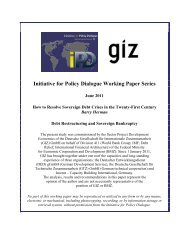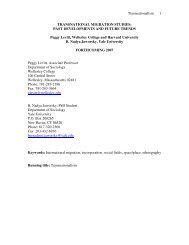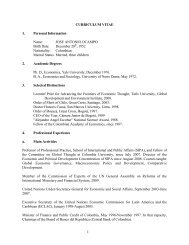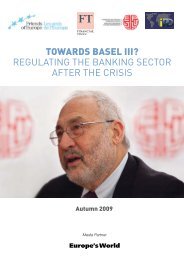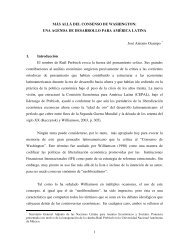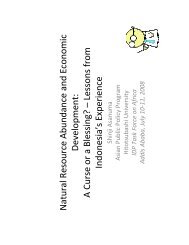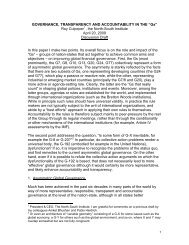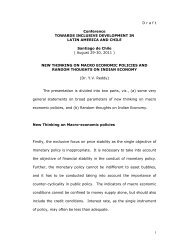Paper - Initiative for Policy Dialogue
Paper - Initiative for Policy Dialogue
Paper - Initiative for Policy Dialogue
You also want an ePaper? Increase the reach of your titles
YUMPU automatically turns print PDFs into web optimized ePapers that Google loves.
10<br />
<br />
GDPGrowthRegionalComparision<br />
9.00%<br />
8.00%<br />
7.49%<br />
8.17%<br />
7.33%<br />
GDPGrowthRate(%)<br />
7.00%<br />
6.00%<br />
5.00%<br />
4.00%<br />
3.00%<br />
2.00%<br />
2.94%<br />
4.63%<br />
3.52%<br />
2.50%<br />
5.45%<br />
5.89%<br />
3.88%<br />
2.50% 2.55%<br />
1.00%<br />
0.00%<br />
19602006 19802006 19952006<br />
SubSaharanAfrica EastAsia&Pacific SouthAsia LatinAmerica&Caribbean<br />
III. Global Experience: The Cases and Ingredients of Success<br />
Africa’s poor per<strong>for</strong>mance is especially disturbing when seen in a global perspective.<br />
The period of African stagnation corresponded to a period of rapid growth in East Asia.<br />
The causes of that growth have been the subject of extensive discussion, including an<br />
important study by the World Bank itself, The East Asian Miracle.<br />
A more recent study, the Growth or Spence Commission (as it is often referred to and<br />
what we label as GSC) has revisited the issues on a global scale and seeks to extract<br />
policy lessons from the experience of 13 countries which achieved annual growth rates of<br />
7% or more <strong>for</strong> at least 25 years. 9<br />
The countries and their periods of sustained growth at the rates that GSC concerns<br />
itself with are as follows: Botswana 1960-2005; Brazil 1950-80; China 1961-2005;<br />
Hong Kong 1960-97; Indonesia 1966-97; Malaysia 1967-97; Japan 1950-83; S. Korea<br />
9 Whilst GSC devotes a chapter to country contexts in which it looks at the implications of its analysis<br />
<strong>for</strong> Sub-Saharan Africa; small economies and those rich in natural resources; it does so in a rather broad<br />
brush manner (e.g. only 7 pages on Africa) especially in comparison with its carefully detailed and nuanced<br />
general discussion of growth issues. The Report does not aim to fully engage directly with the growth<br />
debate in Africa, <strong>for</strong> example on the role of geography it simply notes that many countries are landlocked<br />
with a muted suggestion that that is part of the reason <strong>for</strong> Africa’s disappointing growth per<strong>for</strong>mance but<br />
does not examine the issue in any detail (we examine this issue later). This reflects the fact that its focus is<br />
broad, ambitious and general or at any rate considerably more so than that of the Africa Task Force. The<br />
Commission’s report is mindful of the dangers of excessive or excessively rapid capital account<br />
liberalization but does not pay much attention to other aspects of the financial sector (e.g. domestic<br />
financial restraint; directed credit or the role of DFIs).



